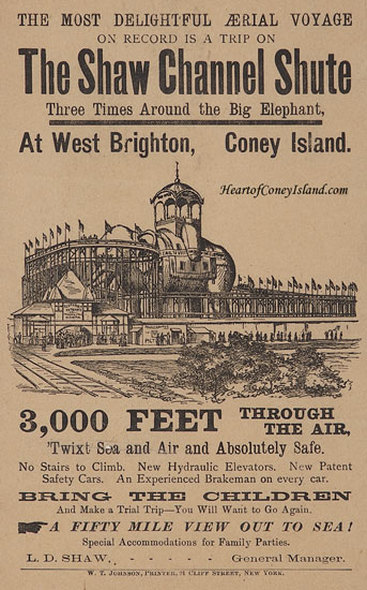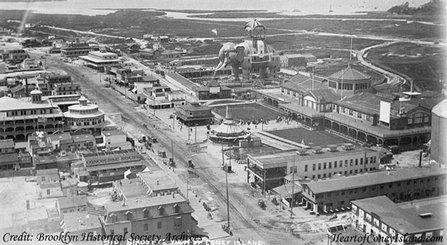Coney Island History: The Elephant Hotel and Roller Coaster (1885-1896)
 The Shaw Channel Chute, because every Elephant Hotel deserves its very own roller coaster. The local flag salesman clearly was persuasive as well.
The Shaw Channel Chute, because every Elephant Hotel deserves its very own roller coaster. The local flag salesman clearly was persuasive as well.
In May of 1885, after two years of construction, a new and unique creation rose on the west side of Sea Beach Palace at West Brighton, Coney Island. This handsome pachyderm was neither of the better-known African nor Asian varieties, but of a species altogether indigenous to the United States.
The Elephant Hotel, also known as the Jumbo Hotel, was fathered by a James L. Lafferty. He thought that the next great step forward for architecture was to design buildings in the shapes of animals, birds, and even fish.
Roughly ten years earlier at West Brighton, Lafferty had constructed the Inexhaustible Cow for Paul Bauer. This popular stand provided drinks, from milk to champagne, for parched Coney throats. The Cow would prove to be small potatoes compared to Lafferty's masterpiece.
Lafferty had tested his elephant idea a few years earlier, when he built a small one at Margate, near Atlantic City. He decided to go all-in for his Coney Island creation. The Elephant Hotel at West Brighton was a giant, 31-roomed, 176-foot-tall, 203-foot-long structure. Its legs housed shops and had stairs leading up to the main floor in the creature's innards. Here was a restaurant, as well as a bar and meeting rooms. The floors above had sleeping accommodations, and on the roof was a howdah, which served as an observation tower. It was said that five thousand people could fit comfortably in the various rooms of this creature.
Until the Statue of Liberty was erected in late 1886, the Elephant Hotel was the first thing that astonished immigrants saw as they sailed by Brooklyn into lower Manhattan’s Castle Garden Immigration Depot. The Elephant's owner claimed that it was the eighth wonder of the world, but some referred to it as a monstrosity. Whichever was correct, every newly-minted American arrived knowing that there was something rather interesting about this place called West Brighton.
By 1887, the novelty was wearing off a bit, and animal buildings were not looking to be the hits that Lafferty thought they would be. Most visitors to West Brighton perhaps ventured over to get a cigar in the tobacco shop in one of the Elephant's feet. If they hung around a little longer, they may have gotten a sneaking suspicion that the hotel was actually operating as a brothel. In fact, 'going to see the Elephant' became a popular euphemism for getting frisky.
At this precise moment, a fellow by the name of Lorenzo Shaw came knocking. Shaw was not the kind of man who visited the Elephant for cigars or women, however. All Lorenzo Shaw could think about was his desire to dress this financially-ailing Elephant in a massive three-loop, 75-foot-tall, half-mile long roller coaster.
The Elephant Hotel, also known as the Jumbo Hotel, was fathered by a James L. Lafferty. He thought that the next great step forward for architecture was to design buildings in the shapes of animals, birds, and even fish.
Roughly ten years earlier at West Brighton, Lafferty had constructed the Inexhaustible Cow for Paul Bauer. This popular stand provided drinks, from milk to champagne, for parched Coney throats. The Cow would prove to be small potatoes compared to Lafferty's masterpiece.
Lafferty had tested his elephant idea a few years earlier, when he built a small one at Margate, near Atlantic City. He decided to go all-in for his Coney Island creation. The Elephant Hotel at West Brighton was a giant, 31-roomed, 176-foot-tall, 203-foot-long structure. Its legs housed shops and had stairs leading up to the main floor in the creature's innards. Here was a restaurant, as well as a bar and meeting rooms. The floors above had sleeping accommodations, and on the roof was a howdah, which served as an observation tower. It was said that five thousand people could fit comfortably in the various rooms of this creature.
Until the Statue of Liberty was erected in late 1886, the Elephant Hotel was the first thing that astonished immigrants saw as they sailed by Brooklyn into lower Manhattan’s Castle Garden Immigration Depot. The Elephant's owner claimed that it was the eighth wonder of the world, but some referred to it as a monstrosity. Whichever was correct, every newly-minted American arrived knowing that there was something rather interesting about this place called West Brighton.
By 1887, the novelty was wearing off a bit, and animal buildings were not looking to be the hits that Lafferty thought they would be. Most visitors to West Brighton perhaps ventured over to get a cigar in the tobacco shop in one of the Elephant's feet. If they hung around a little longer, they may have gotten a sneaking suspicion that the hotel was actually operating as a brothel. In fact, 'going to see the Elephant' became a popular euphemism for getting frisky.
At this precise moment, a fellow by the name of Lorenzo Shaw came knocking. Shaw was not the kind of man who visited the Elephant for cigars or women, however. All Lorenzo Shaw could think about was his desire to dress this financially-ailing Elephant in a massive three-loop, 75-foot-tall, half-mile long roller coaster.
 Elephant Hotel next to Sea Beach Palace, c. 1886
Elephant Hotel next to Sea Beach Palace, c. 1886
The Shaw Elevator and Channel Chute Company Limited was incorporated December 4, 1888, in New York City. The roller coaster opened in 1889. Shaw advertised for concessionaires in a local June 1889 newspaper, stating that he recently had erected 'a new structure', a 'Mammoth Toboggan Chute, 75 feet high, around the Elephant, giving a ride of nearly a mile through the air, at a high rate of speed', that had 'already drawn tens of thousands of visitors'. The '3,000 feet through the air' that Shaw advertised elsewhere was only 57% of a mile, but Shaw rounded up as needed.
The roller coaster itself would feel quite slow by modern standards. Still, using gravity, it managed to pick up enough speed to require 'an experienced brakeman on every car'. It definitely would have been more exciting to someone back then than to us today. After all, this was before cars, and even the modern bicycle with two equally-sized wheels had just been invented a few years earlier.
The scenic view, not speed, was the point of Shaw's ride. The only taller structures at Coney Island at the time the Shute opened would have been the Elephant itself and the 125-foot Iron Tower. This was just before the Ferris wheel was invented in 1893 and before Captain Paul Boyton opened his Shoot-the-Chutes at Sea Lion Park behind the Elephant. The Shaw Channel Shute may have been slightly shorter, but it could have been a more interesting way of getting a rooftop view than the Iron Tower. Hydraulic elevators were sufficiently common by 1889 that Shaw’s mention of it was just to reassure parents that they would not have to carry their children up the equivalent of seven stories to get to the top.
The Elephant Hotel burned in September of 1896 after several years of not being used, and took our beloved Shaw Channel Chute with it. Less than ten years later, the great Luna Park would be built on the same grounds. We would expect the replacement to be nothing less.
The roller coaster itself would feel quite slow by modern standards. Still, using gravity, it managed to pick up enough speed to require 'an experienced brakeman on every car'. It definitely would have been more exciting to someone back then than to us today. After all, this was before cars, and even the modern bicycle with two equally-sized wheels had just been invented a few years earlier.
The scenic view, not speed, was the point of Shaw's ride. The only taller structures at Coney Island at the time the Shute opened would have been the Elephant itself and the 125-foot Iron Tower. This was just before the Ferris wheel was invented in 1893 and before Captain Paul Boyton opened his Shoot-the-Chutes at Sea Lion Park behind the Elephant. The Shaw Channel Shute may have been slightly shorter, but it could have been a more interesting way of getting a rooftop view than the Iron Tower. Hydraulic elevators were sufficiently common by 1889 that Shaw’s mention of it was just to reassure parents that they would not have to carry their children up the equivalent of seven stories to get to the top.
The Elephant Hotel burned in September of 1896 after several years of not being used, and took our beloved Shaw Channel Chute with it. Less than ten years later, the great Luna Park would be built on the same grounds. We would expect the replacement to be nothing less.
Return to Coney Island History Homepage
